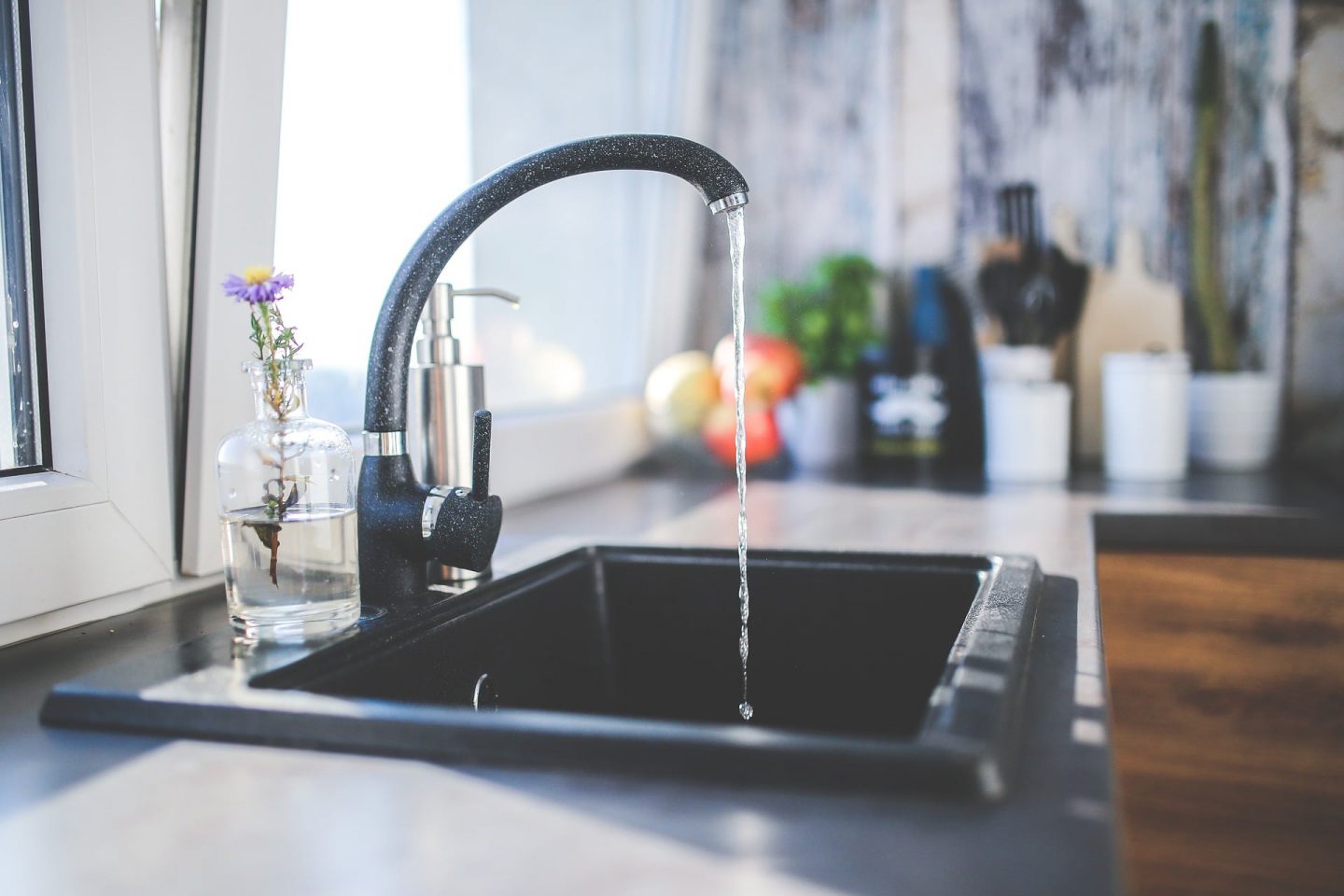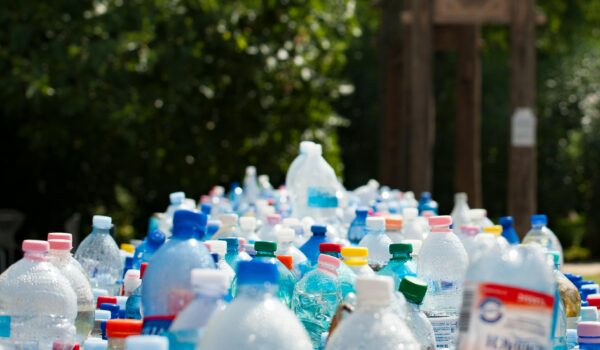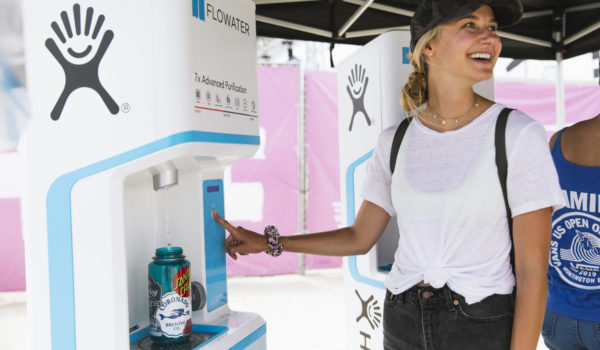Fluoride is a naturally occurring mineral released from rocks into soil… so, does tap water have fluoride in it? Yes, although contrary to popular belief, the levels of natural fluoride in tap water typically are too low to prevent tooth decay. Therefore, it’s common practice for communities to increase fluoride concentration levels in public water systems to levels that are known to help with dental health. This is referred to as community water fluoridation and has been in practice for over 70 years.1
According to the U.S. Department of Health and Human Services (HHS) Federal Panel on Community Water Fluoridation, the recommended optimal fluoride concentration in tap water is 0.7 milligrams/liter. This amount is what the department has deemed the best balance of dental protection with a limited risk of dental fluorosis. This guidance is meant for the community water system that already contains fluoride and wishes to increase the fluoride level to the water supply to promote oral health.2
Fluoride helps build and strengthen the tooth’s enamel, which is worn away by bacteria in the mouth that produces acid. By adding fluoride to tap water at levels outlined by HHS, there are benefits, such as fewer or less severe cavities, less need for fillings, and less pain due to tooth decay. However, because unregulated or excessive fluoride levels in tap water can lead to damage of the enamel, it could be more beneficial to receive fluoride through other sources such as toothpaste, mouthwash, and other dental hygiene products.
Understanding the effects of fluoridated tap water and how the levels of fluoride in drinking water may fluctuate from city to city can help you determine whether or not advanced filtration is an important step to take. Though there may be benefits to the presence of fluoride in tap water, there also are drawbacks to consider as well.
Effects of Fluoridated Water
Dental fluorosis refers to visible changes to tooth enamel, particularly after fluoride consumption from the public water system when teeth are developing. According to HHS, the risk of this development in permanent teeth begins at birth and up to eight years of age, when tooth enamel maturation is complete. For young children (ages six months to 14 years), drinking tap water accounts for anywhere from 40% to 70% of total fluoride intake, at a time when their teeth are most susceptible.
During a child’s developmental stages, it’s best they refrain from drinking fluoridated water to prevent the risk of dental fluorosis. This is for children who drink directly from the tap. It is also for babies who may drink formula that’s been mixed with tap water. However, for older children and adults, added fluoride may help with dental caries, or the decay and crumbling of the tooth.
Due to the risks and benefits at different ages, it’s important to know the levels of fluoride content in drinking water and provide alternatives when necessary. This is why it’s a great reason to get a water dispenser for home. Public water systems are required to provide an annual Consumer Confidence Report (CCR) to customers. The CCR shares levels of different minerals found in tap water, outlining the quality of water and how it is treated.
Since this data is only released once per year, levels of chemicals, minerals, and contaminants can change significantly from report to report, which possibly exposes people to community drinking water that could potentially be harmful to their health. To err on the side of safety, people in communities with high levels of fluoride content in tap water might consider using other drinking water sources such as a purified water machine.
Bottled water used to be the go-to alternative of choice. However, most bottled water is sourced from tap water, which means there’s likely varying levels of fluoride found in bottled water as well. It’s not required for bottled water manufacturers to list the amount of fluoride on the label unless fluoride has been added.
Does the City’s Water Filtration System Remove Fluoride?
Depending on the type and level of filtration your city’s public water system uses, it may remove fluoride along with other particles, chemicals, and pollutants normally found in an originating water source. There’s not a differentiation between what stays and what goes as water is passed through a filter.
Even though fluoride may initially be removed, it is likely then added back in per amounts approved by the Centers for Disease Control and Prevention (CDC) and the U.S. Environmental Protection Agency (EPA). Most community water systems follow a similar water treatment system that regulates the level of contaminants found in tap water.3 This process involves:
- Coagulation and flocculation. This initial step adds positively charged chemicals to the water source, which neutralizes the negative charge of dirt and other dissolved particles typically found in groundwater. This process causes these particles to bind with the chemicals and form larger particles referred to as flocc.
- Sedimentation. Due to the weight of the flocc, it separates out and settles to the bottom of the drinking water supply, which is referred to as sedimentation.
- Filtration. Once the sedimentation process has taken place, the clear water on the top then gets passed through filters of varying pore size to remove dissolved particles, such as bacteria, viruses, and parasites.
- Disinfection. Finally, the water is disinfected with either chlorine or chloramine to kill any remaining parasites and viruses and to protect the water from germs as it passes through home and business water pipes.
Although the steps of the process are often the same in different communities, water disinfection varies from community to community. Additionally, original water sources and filtration systems affect the type of contaminants of water sources. Not all cities have the same levels. Many major municipalities have been cited for undrinkable tap water due to poor water treatment practices, old and outdated water pipe systems, and heavily contaminated water sources.
The Importance of Commercial Water Filtration
There are several advanced water filtration options when deciding how to get rid of fluoride in water. These include reverse osmosis and distillation processes, which each vary in their capabilities to reduce the fluoride level. There’s also activated carbon filtration, which does not remove fluoride from tap water, but is effective in removing other pollutants.
Reverse Osmosis
Reverse osmosis systems work by reversing the flow of water in a natural process of osmosis. This passes water from a more concentrated solution to a more dilute solution through a semipermeable membrane.
The pore size of a reverse osmosis filter is approximately 0.0001 micron, making it a highly- effective method in removing bacteria, viruses, and certain chemical contaminants, including sodium, chloride, copper, and chromium. Reverse Osmosis is also an effective method for removing lead from water. It may also help reduce the level of arsenic, fluoride, and radium found in tap water.4
Distillation
Distillation is the process of heating water to a boiling point and then collecting the water vapor that’s condensed, leaving behind many of the contaminants. It, too, is highly effective in removing bacteria and viruses, and will remove common chemical contaminants, such as arsenic, chromium, lead, and sulfate.
Activated Carbon Filtration
Activated carbon filters are what is found in most refrigeration systems and can remove some volatile organic compounds (VOCs) that cause tap water to smell or taste unpleasant. Though they may be effective in removing some parasites and chemicals, it’s mainly used to help water taste better. Reverse osmosis and distillation are more effective at removing contaminants and pollutants from tap water, in addition to unpleasant odors and tastes.
 FloWater Advanced Water Purification That’s Convenient and Cost-Effective
FloWater Advanced Water Purification That’s Convenient and Cost-Effective
Consumers today want greater control over what they are exposed to and the convenience of getting what they need, when they need it. In previous decades, bottled water was the overwhelming filtered water solution. However, with the increase of plastic waste affecting the environment, the inconvenience and cost factor of replenishing bottled water for businesses, and the fact that most bottled water is sourced from tap water, it has left people wary of whether what they’re drinking is truly the best option.
The FloWater Refill Station alleviates these concerns and provides businesses a convenient and cost-effective way to provide fresh, purified water that tastes great to their customers and guests. It’s a rapid filtered water dispenser that auto-replenishes quickly for a high capacity of people. Every person gets the same cool, crisp taste of purified water at the perfect drinking temperature of 42 degrees.
Highly Purified Water
It’s the advanced technology of the FloWater’s seven step purification system that sets it apart from other filters and water refill options. Each step of the process is designed to remove up to 99% of all contaminants, chemicals, and pollutants, including fluoride.
The purification system transforms tap water by using the recommended filtration methods recommended by the CDC, including sedimentation, carbon, and advanced osmosis filters. Additionally, there is an activated oxygen filter that naturally sanitizes the systems’ tanks and removes impurities, while also increasing the amount of oxygen available in the water.
Additionally, the alkaline filter adds in a proprietary blend of 10 trace minerals to raise the pH level of the water from the tap and neutralize the acidity in the body to help alleviate stress on internal organs and tooth enamel.
Then, important electrolytes are added back to the water to enhance healthy body functions, like immune defense and cell repair. All of this is finished with a coconut carbon filter that results in the crisp, clean taste that keeps people hydrated. Wondering what is the best pH level for drinking? Well, the best pH level for drinking water ranges from 6.5 to 8.5.
Reduces Need for Plastic
The Flowater Refill Station fits any size of the refillable water container, which allows guests and customers to fill up their reusable water bottles or gallon jugs to stay hydrated when at work, at the gym, or traveling through airports and staying at hotels. Rather than resorting to single-use plastic water bottles, which are a recurring expense for businesses, and costly to the environment, the FloWater Refill Station eliminates this need for plastic altogether.
Convenient Refill Options
The Refill Station holds seven gallons of purified water at all times and is available on-demand to serve a large crowd. This means less gathering and waiting time to fill up for guests. Plus, people have a contactless experience by using the foot pedal. This helps to prevent the spread of germs and the buildup of dirt and grime on the Refill Station itself.
The uncertainty of tap water safety has people searching for other options to stay hydrated. Because people can get fluoride from a variety of other sources, relying on drinking tap water to protect their oral health may not be the optimal way to go.
For more information on how FloWater can help your business, request a quote today!
- “Community Water Fluoridation.” The Centers for Disease Control and Prevention. https://www.cdc.gov/fluoridation/faqs/community-water-fluoridation.html.
- “U.S. Public Health Service Recommendation for Fluoride Concentration in Drinking Water for the Prevention of Dental Caries.” Public Health Reports. U.S. Department of Health and Human Services Federal Panel on Community Water Fluoridation. https://www.ncbi.nlm.nih.gov/pmc/articles/PMC4547570/
- “Water Treatment” The Centers for Disease Control and Prevention. https://www.cdc.gov/healthywater/drinking/public/water_treatment.html
- “ A Guide to Drinking Water Treatment Technologies for Household Use.”The Centers for Disease Control and Prevention. https://www.cdc.gov/healthywater/drinking/home-water-treatment/household_water_treatment.html



